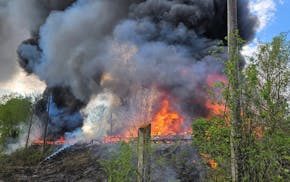Winter, as they say, is coming. And for at least 1,300 homeless Minnesotans, according to researchers at the Wilder Foundation, that means spending cold nights unsheltered — outside, in a car, in a tent or aboard light rail.
That's a significant increase from a decade ago, Wilder officials said. And it will require a concentrated, long-term effort to get people off the streets and into the warmth.
"If we don't address these issues in a meaningful way, we are just pushing them into the future … and they will just become more complex," said Stephanie Nelson-Dusek, a scientific research writer for Wilder. "And it becomes more expensive. Also, are we going to let these folks stay outside when we could let them in?"
Wilder Research has been conducting its Minnesota Homeless Study since 1991, surveying homeless residents every three years. In 2023′s survey, 23% of the homeless population said they'd spent at least half the previous month outside. That was up from 13% in 2012.
In Wilder's most recent survey, conducted from September to October in 2023, 39% of Minnesota's homeless population reported spending at least one night of the previous month outside. And, of those who reported being outside 15 or more days the previous month, 32% were Native American. Native Americans make up just 2% of Minnesota's adult population.
Wilder officials said that disproportionality is larger for Native Americans than any other racial or ethnic group.
Those numbers don't surprise Mike Goze of the American Indian Community Development Corp. He's been working with homeless people at the corporation for 17 years. That so many Native people stay outside despite the development of more shelter beds and new scattered-site housing is a direct reflection of growing power of addiction, Goze said. Shelters, families and friends often won't accept people who are actively using drugs.
"There was a time when people were couch hopping, staying with friends or family," he said. "But if they're addicted, people can't be trusted. And folks don't let them stay."
He added: "You can't force people into anything. You can't force them into treatment. You can't force them into housing."
That's especially true with a growing number of young people using fentanyl at $2 a pill to self-medicate, he said.
"It's a problem that we have to do more about. I don't know what we're doing that works," Goze said. "You're dealing with a population that doesn't have a lot of hope."
Other findings from the study
The Wilder Minnesota Homeless Study for 2023 highlighted a number of other findings, including:
- Unsheltered women experience much higher rates of violence and exploitation than men.
- About 84% of people who slept for 15 nights or more outside had mental health or substance-use challenges, compared to 63% who were sheltered for the full month.
- Of those who were unsheltered for 15 or more nights, 70% had served time in the criminal justice system. For those who recently served time, 84% had been homeless upon entering incarceration and 71% did not have stable housing when leaving.
- About 78% of Minnesota's unsheltered population had been homeless for a year or more — or four or more times in the past three years. By comparison, 53% of those who had shelter for the past month were considered long-term homeless.
To better reach unsheltered homeless, a wider range of options need to be developed, Nelson-Dusek said. That includes options developed by communities such as Native Americans themselves. Officials point to successful efforts to get Minnesota veterans off the streets as reason for optimism.
Even with the challenges, Nelson-Dusek said getting 1,300 Minnesotans in out of the cold "doesn't feel like it's insurmountable."

Arson caused fire that engulfed WWII buildings in Arden Hills, fire department says
Body of canoer found in Boundary Waters

Pope Leo XIV calls for peace in Ukraine and Gaza in symbolically rich blessing on Mother's Day

